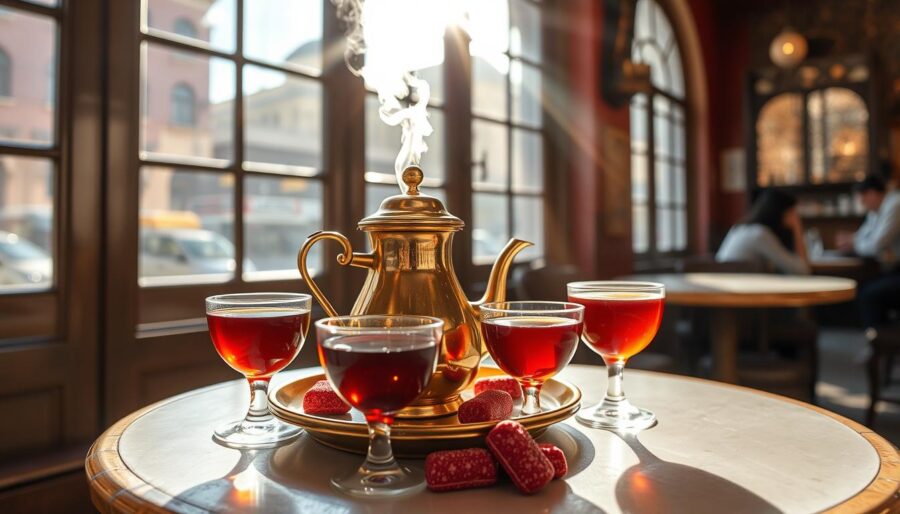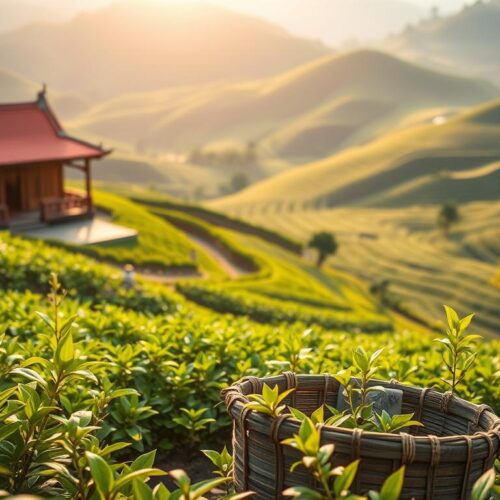Walking into a café in Istanbul, you’ll hear the sound of tulip-shaped glasses. This sound marks the true nature of Turkish tea culture. A small glass of çay offers warmth and friendship, while inviting deep conversations. It’s usually enjoyed without milk, sweetened as you like. Often, it comes with tasty treats like simit, börek, or baklava.
The tradition seems simple, yet it’s very specific. Turkish tea is made in a çaydanlık, which is a special double teapot. This pot brews strong tea at the top and holds boiling water at the bottom. You mix the tea to your taste, watching its deep amber color. The tea stays warm, letting the scent rise with each sip.
In homes, tea gardens, markets, and cafés, çay connects people of all ages and backgrounds. Whether in a çay bahçesi or a bustling kahvehane, you’re part of ongoing conversations that have influenced daily life for years. Tea farming started along the Black Sea coast after WWI. Rize became the center of this. By the 1950s, Turkish tea became a communal drink, overtaking coffee.
Now, Turkish tea is enjoyed far beyond Turkey. Its brewing method and unique taste attract people who seek tranquil moments and genuine connections. Holding that warm glass, you become part of a vibrant tea culture. One that thrives on shared cups and conversations, one at a time.
Introduction to Çay and Its Place in Daily Life
In Turkey, çay greets you at every door. As soon as you take a seat, whether at someone’s home, a lively market, or a Turkish tea house, a small glass of çay is served. This welcoming act is at the core of Turkish tea culture, highlighting the importance of spending time together over rushing.
Çay is a must at breakfast, business meetings, or during a calm afternoon. The tulip-shaped glass showcases the tea’s deep red color and inviting scent. Most prefer it without milk, though some add sugar. Accompanied by simit or börek, it transforms a simple tea break into a delightful experience.
The brewing process is key, using a çaydanlık, a special double teapot. It allows you to adjust the tea’s strength to your liking. This custom of making tea just right makes each serving unique. It connects people, whether they’re at home, shopping, or visiting any Turkish tea house.
In tea gardens and parks, you’ll find people playing backgammon and sharing news. It’s a place where old friends, students, and families come together in harmony. Here, çay acts as a link between people, slowing down the rush of daily life in a soothing rhythm.
From Ottoman Coffee to Black Sea Leaves: A Brief History
We begin with the bustling Ottoman coffeehouses and move to today’s çay. In the late 19th century, tea came from China. Coffee was still king, but Turkish tea became popular for being practical and local.
After World War I, we look at Rize, near the Black Sea. Its climate was perfect for growing tea. With support from the government, tea fields expanded, starting a new era in tea culture.
By the mid-20th century, life changed with the introduction of the teahouse and home samovar. Turkish tea, being cheap and aromatic, became a staple. It symbolized hospitality, intertwining with daily routines.
Soon, drinking tea became a national habit. Turkey became one of the largest tea consumers in the world. This change made Turkish tea a key part of daily life, blending local farming with urban and family traditions.
| Era | Dominant Drink | Key Regions | Forces of Change | Impact on Daily Life |
|---|---|---|---|---|
| 16th–19th centuries | Coffee in Ottoman coffeehouses | Istanbul, İzmir | Trade routes, urban salons | Gatherings centered on coffee rituals and storytelling |
| Late 19th century | Tea introduced as çay | Imports via port cities | Global exchange with China and the Caucasus | Curiosity and gradual adoption within existing tea culture |
| 1920s–1940s | Turkish tea under cultivation | Rize, Black Sea coast | State support, agronomy trials, economic needs | Local supply replaces costly imports; home brewing spreads |
| 1950s–1970s | Çay overtakes coffee in daily use | Nationwide | Affordability, accessibility, teahouse networks | Hospitality expressed with a glass of çay at work and at home |
| 1980s–today | Turkish tea as a cultural mainstay | Rize production, urban cafés | Modern logistics, brand growth like Çaykur | Turkish tea culture shapes routines, from breakfast to late-night chats |
Rize and the Black Sea: Where Turkish Tea Thrives
In Rize, steep hills meet the mist of the Black Sea. The soil here is very fertile and the rain falls regularly. This perfect weather lets the Camellia sinensis plants thrive, making Turkish tea full-flavored and vital to Turkish tea culture.
When people talk about “Rize Tea,” they mean a strong tea with a bold taste. It’s best when made in a çaydanlık, which brings out its unique flavors. The leaves go through several steps, including being rolled and dried, to keep their scent and color.
There’s an easy way to test tea’s freshness at home. Just put some dry leaves in cool water. If the color changes slowly, the tea is fresh and high-quality. But if it changes quickly to dark, the tea might not be as good.
With government support in the 20th century, Rize became a tea hotspot. Its tea makes its way into homes and tea gardens all over, from Istanbul to Izmir. Each cup connects you to a place where nature, hard work, and traditions create the unique Turkish tea culture.

Brewing with a Double Teapot: Mastering the Çaydanlık
The çaydanlık is a double teapot used to brew Turkish tea. It ensures the tea is clear and well-made. The bottom pot boils water. The top pot mixes loose black tea with a bit of hot water. This process creates a strong tea essence that stays warm but doesn’t get bitter.
First, add some of the strong tea concentrate to a tulip glass. Then, fill the rest with boiled water from the bottom pot. You can make your tea light or strong by changing the amounts. This way keeps the tea’s smell and taste perfect. It also allows each person to make their tea just right.
Get fresh tea leaves, the çaydanlık, tulip glasses, and maybe some sugar. Skip the milk, staying true to Turkish tradition. Pour the tea carefully from a height. This adds air to the tea and looks stylish. Enjoy your tea with sweet baklava, crunchy simit, or a savory börek.
Using a çaydanlık is simple and improves your tea experience. It’s a tradition in tea houses across Turkey. It makes a tea that’s rich in color and taste. This tea goes great with both sweets and salty foods. Turkish tea brings people together with its quality and style.
Glass, Color, and Aroma: The Significance of the Tulip-Shaped Tea Glass
The tulip-shaped glass has a special design. It narrows in the middle and then flares out gently. This shape is not just for looks. It keeps the heat trapped and the rim cool. It also makes sure you smell the lovely aroma of Turkish tea first.
Its clear sides let you see the tea’s color. This color changes from ruby to deep amber, showing the tea’s strength. So, you can easily tell how strong your tea will be with just a look.
The glass’s small size has a purpose too. It lets you finish your tea while it’s still hot. Then, you’re ready for a refill. This encourages chatting and taking your time. It reflects the Turkish way of enjoying tea together, sharing stories and caring by offering more tea.
Presentation affects how we taste. In a see-through glass, the tea’s color shows its strength. This helps you mix just the right amount of strong tea and hot water. People add sugar if they like, but milk is never added. This keeps the tea clear and preserves its complex flavors.
This unique glass is used everywhere in Turkey. You see it in homes, çay gardens by the sea, and even in the bustling Grand Bazaar. Its shape is now a symbol of hospitality and quality. Holding this glass makes any tea time special. It connects you to the rich world of tea culture with every sight, smell, and sip.
Turkish tea culture
Turkish tea culture greets you quietly with a fresh glass for a guest. At home, afternoon tea becomes a feast of börek, kısır, sarma, and kurabiye. You share stories and enjoy the moment, as steam rises from the tea.
Women host tea days, combining home cooking with knitting, embroidery, and games. Kids often come for seconds, showing how tea keeps families together.
You’ll find tea houses, çay bahçesi, or kahvehane buzzing with games and news outdoors. In Istanbul, people of all sorts gather at plazas and cafés by the sea. Everyone orders their tea just how they like it — usually without milk.
Turkish tea is there for all times, whether in joy or sorrow, at celebrations or deep conversations. This ritual emphasizes calm and togetherness over rushing, no matter where you are.

Styles and Flavors: From Classic Black to Regional and Herbal Teas
Turkish tea starts with classic black leaves from Rize. This tea shines a deep amber, tastes bold, and has just the right sharpness. Enjoy it from a tulip glass, adding hot water and sugar to your liking. This matches well with the culture of tea drinking.
In the east, teas might taste fruity or a bit spicy, like the local food. Coastal areas offer teas infused with herbs, perfect with seafood or simple snacks. Despite these differences, the art of making Turkish tea stays the same: take your time brewing, aim for a clear color, and keep it warm.
Herbal teas offer a caffeine-free option. Rose hip brings a tart and fragrant ruby-colored drink. Linden flower creates a sweet, honey-like taste, great after eating. Apple tea mixes black tea with apple for a sweet drink that still respects Rize’s tea culture.
When picking tea for home, freshness and even tea leaves are key. Look for a tea that shows its true color slowly in water. Quality black tea from Rize should taste clean and end on a brisk note. This way, you can enjoy both strong black and light herbal teas without missing the essence of Turkish tea.
| Style | Origin/Focus | Flavor Profile | Best For | Brewing Tip (Çaydanlık) |
|---|---|---|---|---|
| Classic Black (Rize) | Rize, Black Sea | Strong, rich, slightly astringent | Everyday Turkish tea and food pairing | Use a concentrated upper pot; dilute to a clear amber in the glass |
| Fruit-Influenced Black | Eastern regions | Bright, gently sweet, aromatic | Afternoon breaks and light pastries | Add a small fruit note after brewing to preserve tea clarity |
| Spiced Black | Eastern markets and home blends | Warm spice, round body | Cool evenings and shared trays | Steep spices briefly to avoid masking çay character |
| Rose Hip (Herbal) | Botanical blend | Tart, ruby, vivid aroma | Caffeine-free night sips | Lower water temperature; shorter steep for clean acidity |
| Linden Flower (Herbal) | Botanical blend | Soft, honeyed, floral | After-meal relaxation | Gentle heat; do not boil to keep florals intact |
| Apple Tea Blend | Tourist-favorite style | Sweet, friendly, apple-forward | First-time tasters and casual sipping | Brew black base normally; add apple flavor in the cup for balance |
Experiencing Çay in Istanbul and Beyond
In Istanbul, Turkish tea is everywhere you look. You might find it at a café by the Bosphorus, a busy tea house near the Spice Bazaar, or at a bakery where simit is sold. Each place offers tea in a tulip-shaped glass. It’s served without milk, and you can sweeten it as you like. The strength of the tea is controlled by the çaydanlık.
Turkish tea encourages you to take your time. As you sip your tea, you can watch ferries in Karaköy. You might hear spoons clinking in Sultanahmet. Friends could be playing backgammon nearby. In a Turkish tea house, talking about work feels less stressful. Even a quick tea break can become a special moment in Turkish tea culture.
The journey doesn’t end in Istanbul. It stretches to the Black Sea coast, towards Rize. There, tea grows on terraced hills, showing how the climate and landscape influence Turkish tea. Meeting the people who grow tea, you’ll learn about their lives. And tasting the tea gives you a glimpse into local traditions.
All over Turkey, tea signifies hospitality. Whether it’s a market stall or a village home, you’ll be welcomed with tea. You might sit with locals or join a group in a bustling square. No matter where you are, Turkish tea brings everyone together.
- Typical order: strong base from the çaydanlık, diluted per your taste
- Glassware: tulip-shaped, clear, to judge color and aroma
- Pairings: simit, börek, and quick bites during a stroll
Exploring Turkish tea is like reading a book of daily life. The way it’s poured, its color, and the moments between sips say a lot. Whether on a quiet quay in Istanbul or a hill in Rize, that simple glass of tea connects people and places.
Conclusion
You came for the taste of Turkish tea, but you stayed because of the ritual. This culture combines history, location, and people in one daily ceremony. From the time the Ottomans turned to tea to the tea fields of Rize, çay’s journey shows a country’s evolution while maintaining strong connections.
You notice this in the simple moments—the steam rising, the sound of spoons tapping, and the breaks that lead to conversation.
The process transforms simple leaves into a shared tradition. The çaydanlık with its two tiers lets you control the tea’s strength. The tulip-shaped glass not only shows the tea’s color but also keeps its warmth.
In tea houses in Istanbul, along the Black Sea, or at a family gathering, Turkish tea means you’re welcome. It’s perfect for both happy and sad times, anchoring casual conversations.
Black tea is most popular, but there’s a variety to discover. You’ll find teas with regional herbs, rosehip, linden, and apple tea that visitors love. Each cup brings you closer to a vibrant tea culture that prefers connection over haste.
Let çay set your pace. Then, you’ll take a piece of Turkey’s friendship with you wherever you go.




